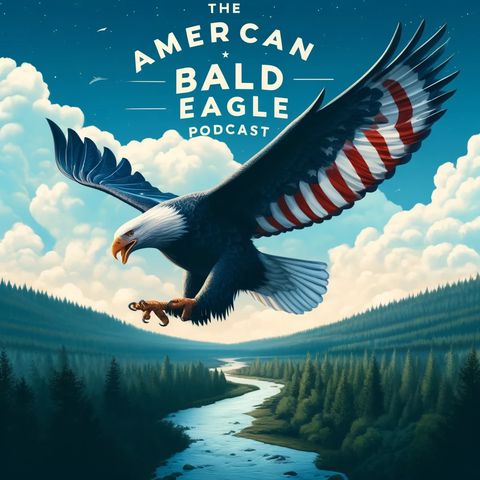Bald Eagles- A Conservation Success Story

Descarga y escucha en cualquier lugar
Descarga tus episodios favoritos y disfrútalos, ¡dondequiera que estés! Regístrate o inicia sesión ahora para acceder a la escucha sin conexión.
Bald Eagles- A Conservation Success Story
Esta transcripción es generada automáticamente. Ten en cuenta que no se garantiza una precisión absoluta.
Descripción
Bald Eagles: A Conservation Success Story The bald eagle, a majestic bird of prey and the national emblem of the United States, has become a symbol of hope and resilience...
mostra másOne of the most significant milestones in the bald eagle's recovery was the ban on DDT in 1972. This decision, which followed the publication of Rachel Carson's groundbreaking book "Silent Spring," helped to reduce the levels of the harmful chemical in the environment and allowed bald eagle populations to begin recovering. In addition to legal protections and the DDT ban, conservation efforts also focused on habitat restoration and management. The U.S. Fish and Wildlife Service worked with landowners and other stakeholders to protect and enhance bald eagle nesting and foraging habitats, including the preservation of old-growth forests and the restoration of wetlands. Captive breeding and reintroduction programs also played a crucial role in the recovery of bald eagle populations. In the 1970s and 1980s, wildlife biologists began collecting eagle eggs from wild nests and hatching them in captivity. The young eagles were then released into suitable habitats, helping to boost populations in areas where the species had been extirpated.
The Bald Eagle Today Thanks to these dedicated conservation efforts, the bald eagle has made a remarkable recovery. In 2007, the U.S. Fish and Wildlife Service removed the bald eagle from the endangered species list, citing a population that had grown to over 9,700 nesting pairs in the contiguous United States. Today, bald eagles can be found in every state except Hawaii, and their population continues to grow. In 2020, the U.S. Fish and Wildlife Service estimated that there were more than 71,400 nesting pairs of bald eagles in the lower 48 states, a testament to the success of conservation efforts and the resilience of this iconic species. The recovery of the bald eagle has had far-reaching ecological and cultural impacts. As apex predators, bald eagles play a crucial role in maintaining the health and balance of the ecosystems they inhabit. Their presence in the wild is also a source of inspiration and pride for many Americans, who view the birds as a symbol of national identity and environmental stewardship. Despite the success of bald eagle conservation efforts, the species still faces ongoing challenges. Habitat loss and degradation continue to be major threats, particularly in rapidly developing areas along the coasts and near large bodies of water. Climate change is also a growing concern for bald eagles and other wildlife species. Rising temperatures, changing precipitation patterns, and more frequent extreme weather events could alter the availability of prey species and disrupt nesting and migration patterns.
In addition, bald eagles continue to face threats from human activities, such as collisions with vehicles and power lines, lead poisoning from ingesting contaminated prey, and disturbance from recreational activities. To address these challenges and ensure the long-term survival of bald eagles, ongoing conservation efforts will be essential. This includes continued habitat protection and restoration, as well as research and monitoring to better understand the impacts of emerging threats like climate change. Engaging the public in bald eagle conservation through education and outreach programs is also crucial. By fostering a sense of connection and appreciation for these magnificent birds, conservation organizations can build support for ongoing protection efforts and inspire a new generation of environmental stewards. The bald eagle's recovery is a powerful reminder of the importance of dedicated conservation efforts and the resilience of nature. It demonstrates that with the right combination of legal protections, habitat management, and public support, even species on the brink of extinction can be brought back from the brink. As we look to the future, the bald eagle's story offers hope and inspiration for other conservation challenges we face. It shows that by working together and taking bold action, we can make a difference in protecting the incredible diversity of life on our planet. The bald eagle's recovery is not just a conservation success story; it is a testament to the power of the human spirit and our ability to correct past mistakes. It is a reminder that we have a responsibility to be good stewards of the natural world and to pass on a healthy and thriving planet to future generations. So, the bald eagle's journey from the brink of extinction to a thriving population is a story of hope, resilience, and the power of dedicated conservation efforts. It demonstrates that with the right combination of legal protections, habitat management, and public support, we can make a difference in protecting even the most vulnerable species. As we celebrate the bald eagle's remarkable recovery, we must also remain vigilant and committed to ongoing conservation efforts. By working together to address emerging threats and engaging the public in the protection of these magnificent birds, we can ensure that the bald eagle remains a symbol of national pride and environmental stewardship for generations to come. The bald eagle's story is not just about the recovery of a single species; it is about the power of individuals and communities to make a difference in the world around us. It is a reminder that we all have a role to play in protecting the incredible diversity of life on our planet and ensuring a sustainable future for all. Thanks for listening ND REMEMBER TO LIKE AND SHARE WHEREVER YOU GET YOUR PODCASTS.
Información
Copyright 2024 - Spreaker Inc. an iHeartMedia Company
